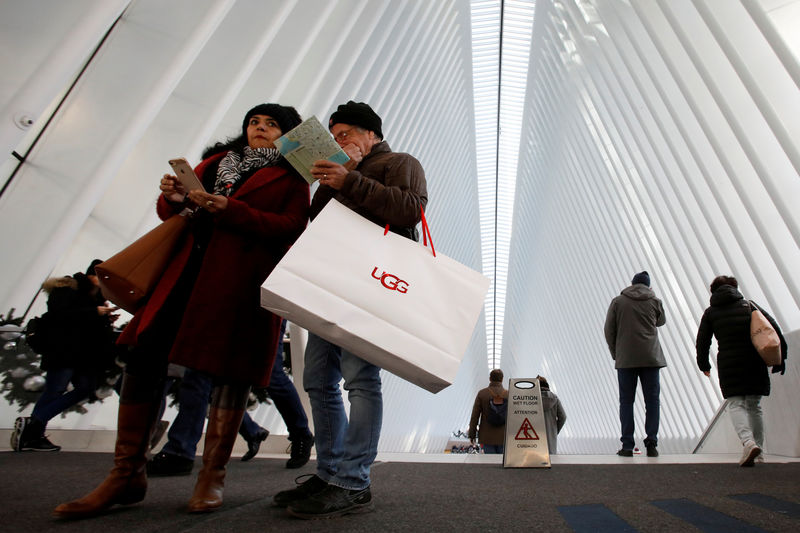By Nandita Bose
NEW YORK (Reuters) - A slowdown in global consumer confidence threatens to overshadow the holiday shopping season in the United States, which despite a strong start is not immune to developments in Europe.
Super Saturday, the last before Christmas and the biggest shopping day of the U.S. holiday season, is likely to bring in more than $26 billion in revenue, retail consultancy Customer Growth Partners (CGP) said, up from $24.5 billion (19.36 billion pounds) a year ago.
But shares in U.S. retailers including Amazon.com Inc (O:AMZN) were hit on Monday after a profit warning from British online fashion retailer ASOS (L:ASOS), showing that even previously high-flying, online-only retailers were vulnerable to deteriorating consumer sentiment.
The U.S. Federal Reserve is expected to raise interest rates again on Wednesday and with European retailers reporting weaker sales and Chinese consumers holding back, there are concerns that U.S. consumers could turn skittish too. U.S. package delivery company FedEx Corp (N:FDX) on Tuesday cut its 2019 profit forecast after Europe's economy weakened and the U.S. trade row exacerbated a slowdown in China.
"Many people are worried that this is as good as it gets, when it comes to spending and consumer confidence," Shawn Kravetz, Esplanade Capital LLC's chief investment officer, said.
A global index of retailers <.TRXFLDGLPUY4> has fallen by more than 17 percent in the past three months.
European gloom deepened on Wednesday after Ceconomy (DE:CECG), Europe's biggest consumer electronics retailer, said it expected profit to fall again. The continent's retailers are grappling with uncertainty over Britain's exit from the European Union, slow economic growth and protests over fuel taxes in France and other factors.
GAS PRICE FUELS SPENDING
Consumers in the United States continue to spend for now and despite a sharp rise in online orders hurting spending in stores during the Thanksgiving weekend, bricks-and-mortar locations have since gained momentum.
Holiday traffic to J.C. Penney (N:JCP) stores increased 10 percent year-on-year from Black Friday through Dec. 10, according to data from Orbital Insight, which analyses satellite imagery such as the number of cars in a retailer's parking lot.
Traffic was 7 percent higher at Target Corp (N:TGT) stores for the period and up 5 percent at Walmart Inc (N:WMT).
A drop in the price of gasoline could insulate U.S. retailers from some of the pain felt elsewhere, with data from the American Automobile Association (AAA) on Dec. 17 showing the national gas price average of $2.37 is the cheapest seen during the month of December since 2016.
"Consumers will definitely notice they have a little more money in their pockets and buy an extra gift or two," said James Bohnaker, associate director, U.S. macro and consumer economics at financial data company IHS Markit. However, he expects the impact on retail spending to be limited.
Others expect a bigger bump. According to CGP, every dime of gasoline price increase or decline adds or takes away about $1.5 billion every month in discretionary spending. Of this, about $500 million, or a third, converts to retail spending.
Last year holiday spending was depressed by about $2.5 billion after a rise in gas prices, but this year the drop in prices is likely to free up about $3 billion in spending, Craig Johnson, president at CGP said.
Johnson said this was particularly a factor for those on lower incomes, adding that "for the first time in three years, gas prices are going to add to spending and not hurt it."
Many on social media expressed excitement at lower gas prices.
"I'm an Uber driver, so with gas prices being lower, it's awesome," Keyhanna (@Keyhanna_J) wrote in a Twitter direct message to Reuters. "I can save a lot more to travel home for the holidays and spend spend spend or pay off some debt before the new year," she said.
BEST IN A DECADE
At U.S. clothing retailers, better designs, fewer discounts and lower inventory, have resulted in less clutter on the sales floor and better customer traffic including at teen chains like American Eagle Outfitters Inc (N:AEO) and some department stores like Macy's Inc (N:M), industry executives said.
"It's the best apparel numbers I have seen in as much as a decade," Steve Sadove, senior advisor at Mastercard (NYSE:MA) Inc said.
That contrasts with Europe where fashion chains including Primark (L:ABF), Superdry (L:SDRY) and Italy's low-cost OVS (MI:OVS) have all warned of weak sales in the run-up to Christmas. And while Zara owner Inditex (MC:ITX) resisted discounting, it reported disappointing sales.
Three consultants told Reuters they expect between 5 to 10 percent growth in U.S. apparel sales this holiday season but cautioned that sales growth at some large department stores like J.C. Penney might be slow.
Demand in the category is being led by athleisure clothing at chains like Lululemon Athletica (O:LULU), Gap Inc's Athleta brand, teen brands like Abercrombie & Fitch Co (N:ANF), and the continued success of off-price clothing chains like TJX (N:TJX), Ross Stores Inc (O:ROST) and Burlington Coat Factory.
Laggards include sporting goods chains, they added. The category includes companies like Dick's Sporting Goods (N:DKS), Bass Pro Shops and Modell's Sporting Goods.
